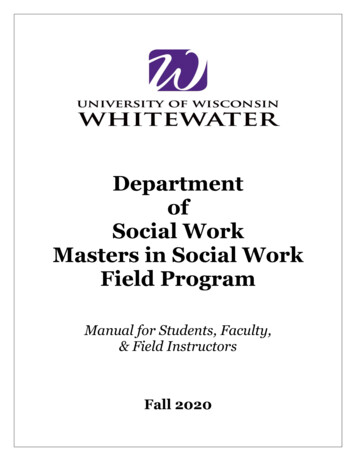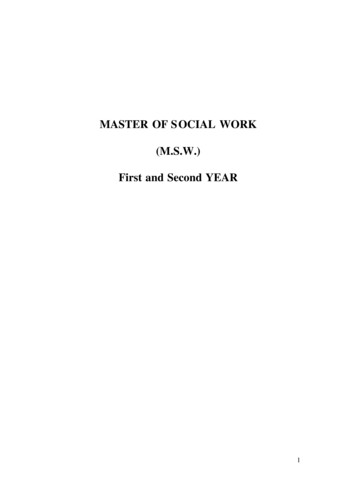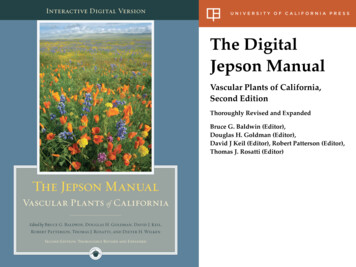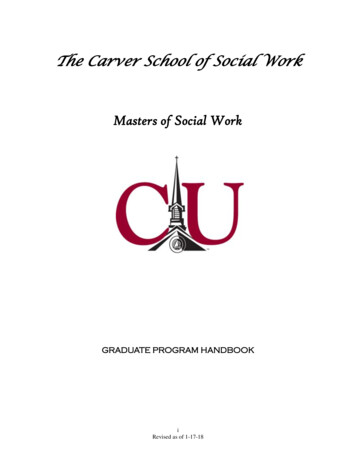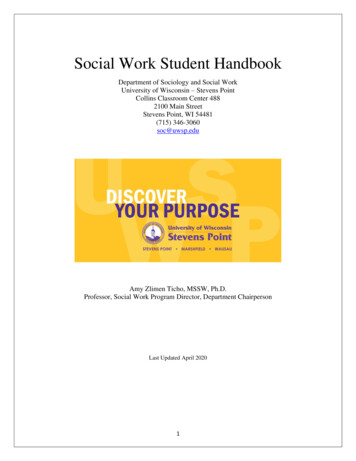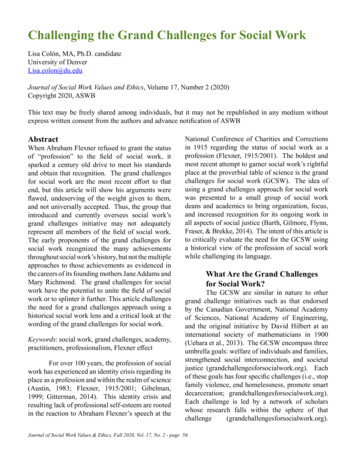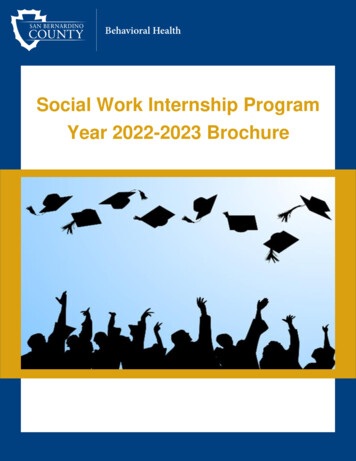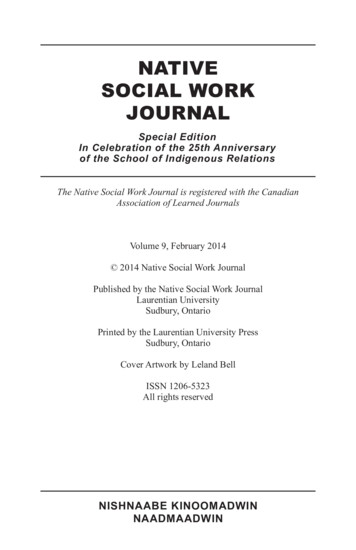
Transcription
NATIVESOCIAL WORKJOURNALSpecial EditionIn Celebration of the 25th Anniversaryof the School of Indigenous RelationsThe Native Social Work Journal is registered with the CanadianAssociation of Learned JournalsVolume 9, February 2014 2014 Native Social Work JournalPublished by the Native Social Work JournalLaurentian UniversitySudbury, OntarioPrinted by the Laurentian University PressSudbury, OntarioCover Artwork by Leland BellISSN 1206-5323All rights reservedNISHNAABE KINOOMADWINNAADMAADWIN
PRAYERDebejiged, Gzhemnidoo, Gmishoomsina.From the purple blanket of the Sky Nation to the first rays ofdazzling light, when Grandfather Sun rises to shine his light on allhis children and creation.Let us embrace the Creator’s love.We are thankful for our mother Shkag Mikwe, Our father, Father Sky. Ourgrandparents; Nookomis-moon and Grandfather Sun.We are thankful for the gifts of the Four Directions and for the combinedsuccesses they bring that we may continue to be of greater service to youand others.We offer ourselves to you as instruments. We trust that you will guide uswith the medicine of leading through example.Teach us to nurture each other, and to encourage each other’s growth, thatwill support the development of others abilities.Help us to be humble and thankful, and to be proud of all accomplishments,through self-esteem and not of self-importance.We humbly ask for continued blessings of life and breath so that, theCreator’s love, our love, maybe felt in the lives of all we meet.Thank you for hearing our prayer. MiigengHilda Nadjiwan
EDITORIAL BOARDLead EditorCheryle Partridge, BSW,(Laurentian) MSW,(UT) RSWAssistant Professor, School of Indigenous RelationsLaurentian Universitycpartridge@laurentian.caCo-EditorsDr. Sheila Cote-Meek, BScN, MBA, (Laurentian) Ph.D. (UT)Associate Vice-PresidentAcademic and Indigenous ProgramsLaurentian Universityscotemeek@laurentian.caSusan Manitowabi, BA, BSW, (Laurentian) MSW,(UT) Ph.D. Candidate (Laurentian)Assistant Professor, School of Indigenous RelationsLaurentian Universitysmanitowabi@laurentian.caDr. Anne-Marie Mawhiney, BA, BSW, (Laurentian) MSW, (McGill) Ph.D. (York)Special Assistant to the PresidentLaurentian Universityammawhiney@laurentian.caNative Social Work Journal Internal Editorial Review CommitteeDr. Sheila Cote-Meek, BScN, MBA,(Laurentian) Ph.D. (UT)Sharon Corbiere-Johnston, BA, HBSW, MSW (Laurentian)Lissa Lavallee, HBSW, (Laurentian) MSW, (Laurier) RSWSusan Manitowabi, BA, BSW,(Laurentian) MSW, (UT) Ph.D. (ABD) (Laurentian)Dr. Anne-Marie Mawhiney, BA, BSW, (Laurentian) MSW, (McGill) Ph.D. (York)Cheryle Partridge, BSW, (Laurentian) MSW, (UT) RSWDr. Taima Moeke-Pickering, B.Soc.Sci, M.SocSci, Ph.D. (Waikato University)Technical and Secretarial SupportFreda Recollet, Secretary, Laurentian UniversityDesign & LayoutTerra MacPhail, Graphic Designerterra@terradesigns.ca
CONTENTSIndigenous Social Work Program(Formerly Native Human Services Programme)1Foreword Dr. Mary Ann Naokwegijiig-Corbiere4Acknowledgements Dr. Sheila Cote-Meek, Susan Manitowabi,Dr. Anne-Marie Mawhiney, Cheryle Partridge6Introduction Cheryle Partridge7Article Submissions and Alumni TestimonialsLike Ripples in Water: 1980-1986Anne-Marie Mawhiney, Thomas Alcoze and Robert Hart11Alumnus1 Testimonial: Lee FrappierAlumna2 Testimonial: Donna CorstonAlumna Testimonial: Agnes KanasaweAlumna Testimonial: Erin VinkleAlumna Testimonial: Sharon Corbiere-Johnston2223252627A Pedagogical Aboriginal ParadigmHerbert C. Nabigon29Alumnus Testimonial: Gus HillAlumna Testimonial: Minnijean Brown TrickeyAlumnus Testimonial: Robin ManessAlumna Testimonial: Katherine Beddows35373838Coming HomeCheryle Partridge41Poem: FOR I AM by Agnes KanasaweAlumna Testimonial: Cynthia BelfittAlumna Testimonial: Shelly Moore-FrappierAlumna Testimonial: Debbie Koski56575859Relationships with the Aboriginal CommunitiesSharon Corbiere-Johnston, Lissa Lavallee and Susan Manitowabi61Alumna Testimonial: Sandra MartinAlumna Testimonial: Jamie-Lea Pollock79811 Alumnus – Male Graduate2 Alumna – Female Graduate
Insights gained from the evaluation surveys conducted with theSchool of Native Human Services students during the periods of2008, 2010 and 2012Taima Moeke-Pickering83Alumna Testimonial: Carol HopkinsAlumna Testimonial: Holly Brodhagen9294Visions of the Way ForwardSheila Cote-Meek97Call for PapersIndigenous Social Work Journal: Volume 10“Issues That Relate to Indigenous Relations”100Call for PapersIndigenous Social Work Journal: Volume 11“Traditional Knowledge in the Helping Professions”103
INDIGENOUS SOCIAL WORK PROGRAMFORMERLY THE NATIVE HUMAN SERVICES PROGRAMMEEstablished in 1988, the Native Human Services Programme utilized aregional consultation process involving twenty-seven (27) First Nationswithin the Robinson-Huron Treaty area. The consultation formed the basisof the curriculum and distance education component of the programme.In June 2008, the Laurentian University Senate approved the NativeHuman Services Unit in becoming a School of Native Human Services,now known as the School of Indigenous Relations, separate from the Schoolof Social Work. This was the realization of a request from the communityin the original consultations of 1988. In April 2008, the School of NativeHuman Services with the support of Laurentian University, applied forstand-alone accreditation with the Canadian Association of Social WorkEducation (CASWE). Accreditation was granted in November 2008. TheNative Human Services Programme is a fully accredited program withCASWE since 2008.The philosophy, content, techniques and strategies that characterize thecurriculum model represent a specialization for obtaining the knowledgeand skills necessary as a social work practitioner with Aboriginalpopulations. The cultural content, practice methods and specificcompetencies reflect distinct realities of self-determination, culturalpreservation and community empowerment.The primary method within the curriculum model utilizes an appliedapproach that focuses critical knowledge in exploring strengths derivedfrom holistic healing approaches. Other curriculum areas include:community based participatory research, Native child welfare practice,socio-cultural ecology theory in family and community systems and casemanagement. A necessary component to the curriculum is the historicpolitical legislative and policy relations, which have defined and continueto have impact upon current socio-economic and political rights ofAboriginal populations.Important and unique as a teaching and learning method is theincorporation of interaction activities with cultural relevance. Holistichealing practices expose students to the role worldviews, values, beliefs,and practices play in cultural based strategies. Additional benefitsto students are the insights provided by participating in a process that1
examines culturally related perceptions of psychological growth andwellness. Finally, such experiential based cultural practices createopportunities for students to explore their own self-cultural awareness.Particularly relevant to this process is that such cultural based practicesact as positive reinforcement in the development of cultural identity andserve to promote Aboriginal healing strategies as a source of interpretativebalance, interpersonal renewal and community aspiration.Native Social Work JournalLaunched in 1997, the Native Social Work Journal is a scholarly andcommunity-based publication committed to the preservation, revitalizationand promotion of the expanding field of Native and Indigenous social workknowledge, theories and practices. Both academic and community-basedresearchers and practitioners have contributed articles representative oftheir communities, their research and frameworks for the best practicewith Native, Aboriginal, First Nations, Métis and Inuit groups as well asother International Indigenous groups. This journal aims to increase thevolume and dissemination of mainly Native authorship and to increasethe accessibility of Native and Indigenous social work scholarship.This journal provides tools for practitioners, academics, social workers,communities and others engaged in Native and Indigenous social workactivities. The Native social work journals are available via print-basedand online. 219/378Field EducationThe main objectives of Field Education are to impart to its graduatesthe ability to apply professional social work methods and approaches in amanner that is culturally appropriate to Aboriginal people.Field Education involves the establishment of field placementopportunities in Native communities. A practicum setting providesthe student an opportunity to apply the knowledge and skills learnedin an actual practice setting. It is a planned and supervised learningexperience for a 3rd year or a 4th year student, which fulfils the practicumrequirements.2
A Native Human Services Field Education Manual has been publishedto guide the students, the field instructor and the faculty consultants inthe field practicum process. The manual is based on traditional Nativeteachings.Distance EducationThe distance component of the Native Human Services Programme isoffered on a part-time basis through ENVISION: Laurentian University’sDistance Education Program. All NSWK courses are alternated each yearand require professional year acceptance into the programme.For specific information on the Native Human Services Programmecontact the Native Human Services Honours Bachelor of Social WorkProgramme at:Phone:Fax:(705) 675-1151 ext. 5082(705) 675-4817Or visit our website at www.laurentian.ca3
FOREWORDThe struggle continues. In the twenty-five years since the inception ofthe Indigenous Social Work program (formerly Native Human ServicesProgramme) here at Laurentian University, we continue to hear new revelations about the deplorable range of abuses inflicted on Indigenous peoples -- people being used unwittingly as subjects of medical experimentsfor instance. As the Truth and Reconciliation Commission criss-crossedCanada, story upon story unfolded revealing the depth of the collectivetrauma First Nations peoples have had to endure, a trauma exacerbated byhaving had control for their families’ and communities’ well-being wrested from their hands by a government that thought it knew what was bestfor them. As it states in its interim report, “the Commission heard fromproud people [who] had survived mental abuse, sexual abuse, physical abuse, and spiritual abuse” (Truth and Reconciliation Commission ofCanada, 2012, p. 6). The seemingly innumerable accounts can be causefor discouragement – or for renewed resolve to persevere in seeking solutions and in striving to heal profoundly damaged communities.The Indigenous Social Work program can take pride in having led theway in ensuring there are appropriately-trained professionals to facilitatehealing of Aboriginal individuals, families and communities well beforethe Commission brought awareness to the nation and beyond of the scaleof the trauma engendered by colonization and subjugation. The needsdocumented by the Native Social Work Project that lay the groundworkfor this program (and in which I was privileged to participate as a teammember) provided but a glimpse of the tasks – and possibilities – of thisprogram. That a program of this type remains vital is underscored by theCommission’s findings. These include the sad fact that “the people whohave been damaged by the residential schools—the former students andtheir families—have been left to heal themselves” (p. 6). The people whocame before it, the Commission reports, “want support for the work theyhave begun in healing .[and] support to allow them to improve parentingskills. In particular, [they] want support in regaining and teaching traditional parenting practices and values” (p. 6-7). Through its courses and itsjournal, the ISW program provides assurance that the Commission’s call“for the development and provision of workshops aimed at reintroducing wise practices for healthy families, and to compensate for the loss ofparenting knowledge experienced by generations of children raised in institutional settings” (p. 7-8) and for the establishment of “health and well-4
ness centres specializing in trauma and grief counselling and treatmentappropriate to the cultures (emphasis added) and experiences of multigenerational residential school survivors” (p. 8) can be met.As the Indigenous Social Work program marks its 25th year, it cantake great satisfaction in the knowledge that it is playing an instrumentalrole in the recovery and reinvigoration of First Nations. That the worksof its faculty and allied scholars and the research shared in this journalare making a difference is evident in the more than two hundred graduates the program has produced since 1988. The number of views of eachedition as recorded by LU Zone serves as another indicator; that numberhas often exceeded 5,000. These contributions mean communities that“for too long, were left to shoulder on their own” (TRC, p. 6) theburden of healing themselves now have support. The faith and dedicationof the members of the Indigenous Social Work program give assurancethat support will only get stronger as each year brings another graduatingclass ready to lean in.Mary Ann Naokwegijijg-Corbiere, PhDReferencesTruth and Reconciliation Commission of Canada (2012). Truth andReconciliation Commission of Canada: Interim Report. Retrievedfrom http://www.attendancemarketing.com5
ACKNOWLEDGEMENTSBoozhoo; Aanii; Wachiya; Sago; Tansi;Kia Ora; Kwe Kwe; Bonjour; GreetingsWe wish to acknowledge those who had the vision to bring anIndigenous Social Work Program, formerly the Native Human ServicesProgramme, to Laurentian University, all those years ago. In fact, ithas been twenty-five years since the inception of this program. We arecelebrating twenty-five years of success with this Special Edition of theNative Social Work Journal Number 9.The journal is a collaborative effort put forth by four co-editors. Weheld many meetings, phone calls, and e-mail messages to bring thisedition to fruition. It was a labour of love. We are all believers in theSchool of Indigenous Relations and many of us have been here for manyyears. The important link to our students and ourselves is Freda Recollet,who has been the secretary for the school from the beginning.The 9th edition of the journal is celebrating the Indigenous SocialWork Program (formerly the Native Human Services Programme) thus,we decided to include those who are here now and those who were heretwenty-five years ago to write articles about the program. Since theschool revolves around students, we asked a few alumni to contributetestimonials about their experiences while here.A special acknowledgment and G’Chi-Miigwech (many thanks) goesto the Elder from Aboriginal Student Affairs (ASA): Hilda Nadjiwon forher beautiful and inspirational prayer to open this Special Edition of thejournal.We are celebrating all graduates of the School of Indigenous Relations(formerly the School of Native Human Services). We have had graduatesfrom all races included in the Medicine Wheel. Our program is inclusiveof all, and we are always welcoming of whomever chooses our program.Dr. Sheila Cote-Meek, Susan Manitowabi,Dr. Anne-Marie Mawhiney, Cheryle Partridge6
INTRODUCTIONWe must always remember that students are our reason for being here,without the students there would be no faculty or staff. The Native SocialWork Journals were created so the students in our program would haveculture-specific articles to cite when writing their papers. It has clearlyworked as we are now publishing our ninth journal. We have many journalarticles for our students’ use. It has benefitted not only our students butalso students and scholars around the world, whom have been accessingthe journals online. We proudly celebrate twenty-five years with thisSpecial Edition Journal. The journal articles are interspersed with veryenlightening, gratifying, and moving alumni testimonials. The first article by Dr. Anne-Mawhiney, Dr. Thom Alcoze and RobertHart relate how the School of Indigenous Relations (formerly theSchool of Native Human Services) came about. The idea for the schoolbegan with discussions, then came the vision, more discussions withAboriginal community members, Aboriginal politicians, and Elders.The authors describe in fascinating detail how the whole birthing ofan Aboriginal culture-specific social work program came about: fromconception to birth. The second article by Professor Emeritus Herbert Nabigon is abouthow this well-respected Elder taught his classes. Herb used theTeachings of the Elders, the Seven Grandfather Teachings, and theTeachings of the Five Colours of the Medicine Wheel. These arealso known as Aboriginal pedagogy. Herb describes how he wove theteachings into the books used for course work. The teachings he usedin the classroom are now being used by alumni. I am one of thosewho uses Herb’s teachings in my classes, I always tell the studentswhere I heard them first. Herb Nabigon is retired now, but his wordsand teachings live on. The third article by Cheryle Partridge is a narrative about her journeyfrom being an undergraduate student in the School of IndigenousRelations (formerly the School of Native Human Services) to being aprofessor in the School of Indigenous Relations. Cheryle relates howher journey transpired and hopes it will serve to inspire prospectivestudents to make this program their program of choice.7
The fourth article by Sharon Corbiere-Johnston, Lissa Lavallee, andSusan Manitowabi is about the Indigenous Social Work Program’srelationship with the urban Aboriginal and non-Aboriginal urbancommunity. Susan describes the evolution of the program from one ofthree streams of social work (Anglophone, Francophone, Aboriginal)to one stand-alone program and school. She also discusses howimportant research partnerships are to the ongoing growth of theschool. Sharon discusses how critical field education is to the schooland how students are required to serve one placement in an Aboriginalagency/organization and one placement in a non-Aboriginal agency/organization. Sharon has forged strong relationship with thoseagencies. Lissa describes the partnerships with Seven GenerationsEducation Institute and Kenjgewin-Teg Education Institute where weoffer community-based Indigenous Social Work on site. The fifth article by Dr. Taima Moeke-Pickering describes the processof evaluating the students in the School of Indigenous Relations.Her longitudinal surveys of evaluation have brought valuable dataforward to the School of Indigenous Relations. She explains howthe school seriously considered the data and has made changes toimprove the curriculum and the content of courses. The sixth and final article by Dr. Sheila Cote-Meek describes howwe, as a school, are looking back at the past to inform the presentand how these experiences will shape our future. Our vision for thefuture will not be fettered by the blinders of the past because we haveshaken off those blinders and the way forward is clear.The authors of the articles contained within this small but powerfulvolume have written from their hearts so the readers can appreciatethe herculean efforts expended in the challenges which were placedin their way during the past twenty-five years. Each challenge wasmet with humility and respect and doors were opened. Although thereare still many doors along the hallways of academia we are makingour presence known in a good way.Miigwech,Cheryle Partridge8
9
Like Ripples in Water: 1980-1986Anne-Marie MawhineyThomas AlcozeRobert Hart“It is like throwing a rock into water, sending ripples that move furtheraway from the centre, ever further – to where, we do not know. Butthrowing the rock starts a change. Change starts when someonethrows a rock in the water, and the ripples of this long into the futurechange will be felt in a good way by many Anishinaaabe people andcommunities, and beyond.” Thom Alcoze, 1988 when discussing theNative Social Work Project, funded by Health and Welfare Canada.Community Engagement: Anne-MarieThe whole idea seemed impossible to many. There were a number ofpeople who said it would never happen and others who tried to stop theproject in its early years. But Elders, Art and Eva Solomon, told us thatthis project’s time was at hand and all we needed to do was bring the rightpeople together; they said the time was right to establish a culturallysensitive social work program designed by the people for the people (byAboriginal people for Aboriginal people).In 1980 I started to teach at Laurentian University’s School of SocialWork with a deep-seated commitment to ensure that social work studentswould have more knowledge and skill to work across cultures than I didwhen I was a social worker in northern Ontario and Montreal. Based onmy observations and experiences social workers had been ill-equipped towork with cultures different from the dominant Western society. Likewise,texts and social work curricula of the time rarely discussed culture,Indigenous peoples, or the ways that different worldviews influence waysof thinking, doing and helping.Change started slowly with a small ripple in the first year class thatI was teaching at the end of my first year during the spring session. Iasked Thom Alcoze, a professor from the University of Sudbury’sNative Social Work JournalVol 9, pp. 11-21
12Anne-Marie Mawhiney, Thomas Alcoze and Robert HartNative Studies department, to give a guest lecture that would introducesocial work students to Indigenous culture. I was hopeful that at leastsome students would then be interested in signing up for Native Studiescourses as part of their Arts electives. After the class Thom and I startedthe first of many conversations on possible ways of making sure socialwork students would be better equipped to work with Indigenous clients.In our discussions over the next 18 months, Walter Schwager from theSociology Department joined us. One day he said “So are we going to talkor are we going to do something?”We consulted with two well known Elders from the area, Art and EvaSolomon. Art told us to ‘go to the people because they know what to do.”We initially approached the Robinson Huron Chiefs’ Assembly fortheir agreement that we would undertake a process to consider betterways of preparing social workers to have better knowledge, skills andexperience to work appropriately with Aboriginal communities. TheAssembly asked us to go to each community within the Robinson-HuronTreaty Area to obtain consent to proceed. We were provided with initialfunding from Health and Welfare Canada to hire two Aboriginal women,Joan Commanda and Mary Ann Naokwegijig (now Corbiere) to go toeach of the 22 Robinson Huron First Nations communities to talk aboutthe idea of a culturally relevant program of studies and determine whetherthe communities were in agreement with this idea.During the same time we approached colleagues in our own programs,Native Studies and Social Work, to inform them about the project.Initially some colleagues from the Native Studies Department and theSchool of Social Work resisted the idea of the project. A colleague fromNative Studies, James Dumont, raised the very legitimate questionabout whether this would be another colonizing process; such processeshad never turned out well for Indigenous peoples. His question was asignificant moment for me because I realized immediately the importanceof this question for my own role as a non-Indigenous person, if any, withthe project. I realized that I would not be a driver of the change process forthe project; the drivers for change would be from among local Indigenouscommunities. I was prepared to step away at any time if my involvementwould mean the project would not proceed shaped by Indigenous people.Nishnaabe Kinoomaadwin Naadmaadwin
Like Ripples in Water: 1980-198613If I had been determined to continue as ‘the’ change agent, the projectwould have failed as it should have.In the summer of 1983 Thom and I were asked to determine if theRobinson-Huron chiefs were in support of an undertaking to consultthe communities. We convened at Anderson Lake and Chiefs from 22Robinson-Huron communities attended to listen to the proposed idea ofengaging in dialogue with their communities about: whether there should be new ways of educating social work students;if so, what content should be included in such an educational process;andwhether such a program should be established at Laurentian UniversityLooking back to this time, over 25 years ago, much has changed in postsecondary education in Canada for Indigenous peoples, and therefore itmay not seem obvious that this project was groundbreaking in many ways.In particular we were suggesting a collaboration between LaurentianUniversity and local Aboriginal communities as lead partners with fullcontrol over the outcome to the three questions. At the time this sort ofendeavour was new ground for a university.Robert Hart, our funding contact with Health and Welfare Canada hasthis to say about the funding of the Native Social Work Project and how thefunding review process also broke with the normal ways of approving suchprojects. I know that Rob played a key role in advocating for this project,supported eloquently by Art Solomon’s letter, mentioned by Rob. There isno doubt that the Native Social Work Project created ripples at Health andWelfare Canada and in a very good way.Art Solomon’s Letter: RobLet me tell you the story of Art’s letter and how it began your school.My name is Robert Hart. In the early 80s I worked for the federalgovernment, for what was then Health and Welfare Canada. (The Welfarepart has since been sent into exile in whatever we are calling HumanResources these days. I find the shift in language from welfare to humanNative Social Work Journal
14Anne-Marie Mawhiney, Thomas Alcoze and Robert Hartresources chilling.) In those days, the department had two fundingprograms, not surprisingly one for health and another for social welfare.I worked for the latter and it was called National Welfare Grants (NWG).NWG had its rationale in the idea that if the federal government wasgoing to share the costs of social services with the provinces, it was ineveryone’s interest to try continually to create better services or, with oursociety changing so quickly, to create services for issues we were then justbeginning to grapple with. Maintaining people with disabilities in theircommunities, violence against women and child sexual abuse were new,emerging issues then.I had come to NWG having done child welfare work in the north and hadleft that practice completely frustrated with the inability of our approach tokeeping children safe, families whole and communities healthy, especiallyAboriginal communities. I was not the only one. Across the country, theprofession and the communities were all looking for a better way, a waythat would engage people in speaking to what was not working for them,what might work better and how we might get there. The goal of culturallybased social services was beginning to emerge.So it made sense for the Social Work and Native Studies programs to joinforces to develop training that met the standards of both disciplines: highprofessional standards and appropriate cultural forms.Anne-Marie Mawhiney, Thom Alcoze and I met with a number of otherpeople to talk about writing a proposal to fund the development of anintegrated program. It was a cold, grey day and the rain slid down thewindows with an unremitting chill. Art Solomon was there, as the Elderto the program, and he was asked to say an opening prayer. It was assurprising as it was short. “We thank the Creator for the beauty of thisday, in which we are called to carry on the work.” How could anyone seethis damnably damp day as anything other than dismal? But Art did. Ilooked outside and the day seemed less drear, more promising. Begin withgratitude, add work. My attitude made a paradigm shift and I have saidArt’s prayer every morning since.But we had a problem. National Welfare Grants was a professionalprogram. Projects had to be of national significance. Colleagues whohad high standards for project design vetted proposals internally. Eachproposal required a clear methodology and an equally clear evaluationdesign. The reviewers needed to have confidence that the planning wasNishnaabe Kinoomaadwin Naadmaadwin
Like Ripples in Water: 1980-198615solid with a realistic expectation of producing a working model the rest ofthe country could learn from.But this was totally new territory and there were no maps through it. Moreimportant, the program had to be worked out by the people who would useit. Laurentian University serves northern Ontario and its graduates wouldbe northerners who would return home to serve other northerners. Thiscould not be a program made for the University. It had to be one made bythe communities. Anything else would repeat the colonial approach thathad contributed to the communities’ pain and struggles in the first place.So the only appropriate design had to be an open, exploratory one thatinvolved the university working with the communities in a way that madesense to them in order to create an education program that made equalsense. The proposal would be short and simple. It would describe anexploratory process that might go in any direction but could not describea product. Such a proposal had never been submitted before, let aloneapproved.I asked Art to write a letter of support. It came, 3 pages of it, hand written,containing the most eloquent, impassioned plea for understanding andsolidarity that I had ever read. Art penned a damning indictment of theexisting child welfare system. He described the individual and family andc
Susan Manitowabi, BA, BSW, (Laurentian) MSW,(UT) Ph.D. Candidate (Laurentian) Assistant Professor, School of Indigenous Relations Laurentian University smanitowabi@laurentian.ca Dr. Anne-Marie Mawhiney, BA, BSW, (Laurentian) MSW, (McGill) Ph.D. (York) . Indigenous Social Work Program 1 (Formerly Native Human Services Programme) Foreword .


